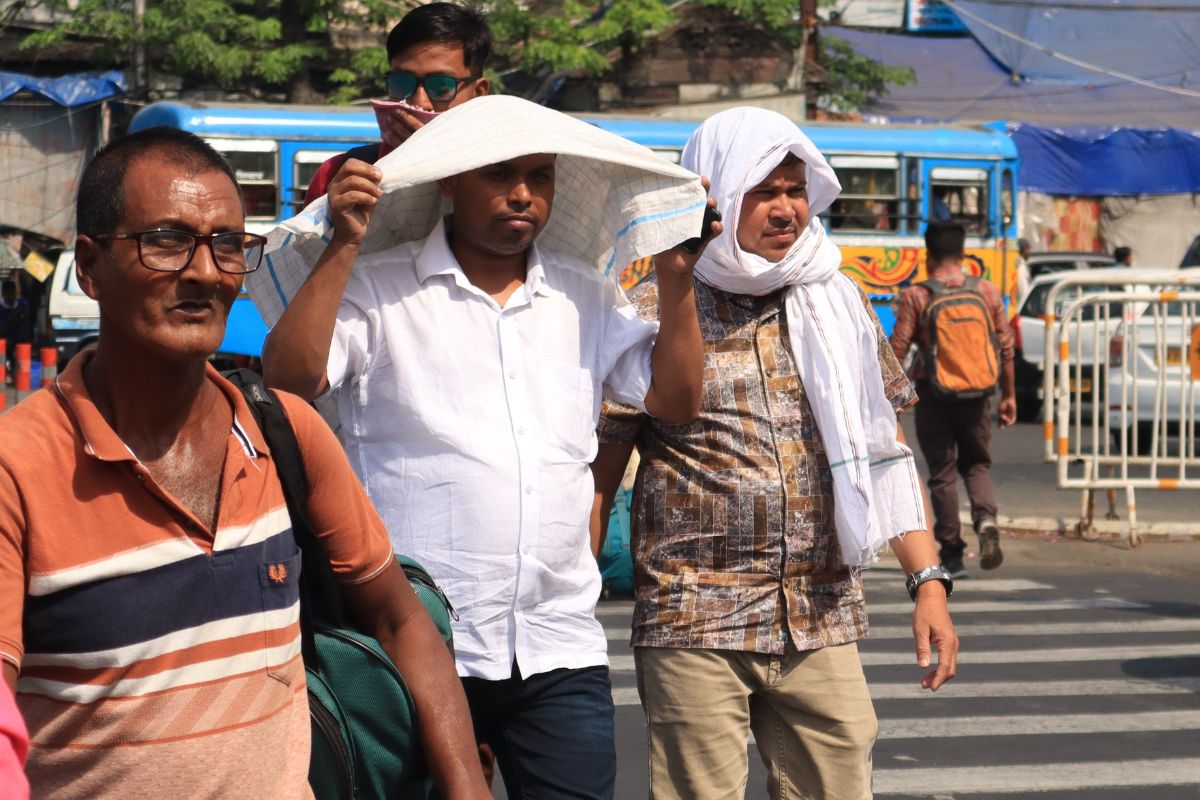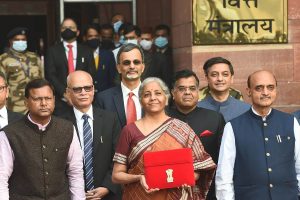Climate science:
India’s rapidly expanding industrialization and urbanisation are already contributing to frequent, prolonged and intense heat waves. A steady change has been observed in Urban Land Cover Change (ULCC), which has increased both Land Surface Temperature (LST) and air temperature and subsequently affected the surface climate.
The year 2023 was the hottest year on record, with a global mean temperature of 1.45 °C above pre-industrial values. Due to El Niño conditions in 2023, all days were more than 1ºC above the pre-industrial level. Close to 50% of days were more than 1.5°C warmer than the 1850-1900 level, and two days in November were, for the first time, more than 2°C warmer.
Last year, April’s record-breaking humid heat wave increased 30 times, more likely due to human-caused climate change, as observed in a rapid attribution analysis by an international team of leading climate scientists as part of the World Weather Attribution Group.
What to expect in 2024:
The average global temperature for 2024 is forecast to be between 1.34 °C and 1.58 °C (with a central estimate of 1.46 °C) above the average for the pre-industrial period (1850-1900): in the 11th year, temperatures will reach 1.0 °C above pre-industrial levels. The forecast is in line with the ongoing global warming trend of 0.2 °C per decade and is boosted by a significant El Niño event.
Impact, mortality & deaths :
This situation is predicted to worsen as heatwaves become more frequent, intense, and long-lasting. These waves can exacerbate chronic health conditions, vector-borne diseases, air pollution, droughts, and other socio-economic pressures, causing higher mortality and morbidity. High temperatures can aggravate long-lasting damage to human organs and worsen pre-existing comorbid conditions, including dehydration, kidney and heart problems, and mental health issues.
Historically, heat has diminished 24,000 lives across the country since 1992. Such deaths have increased by 55% between 2000-2004. Elevated temperatures have also intensified health risks from 2017 – 2021 and are linked to a heavy health burden, resulting in nearly 47,000 early deaths in 2019 (The Lancet).
The World Health Organization estimates that between 2030 and 2050, climate change could cause approximately 250,000 additional deaths per year globally due to malnutrition, malaria, diarrhoea, and heat stress. These heat-related impacts of climate change on mortality are expected to be most severe in South, East, and Southeast Asia.
West Bengal:
The region has been experiencing heatwave conditions with daily maximum temperatures on a constant rise.
Bengal ranked second after Andhra Pradesh on India’s heat vulnerability index in a study conducted by Cambridge University, placing the state in the “extreme danger” category. According to the Intergovernmental Panel on Climate Change, Kolkata recorded the highest increase of 2.6°C in surface air temperature globally between 1950-2018.
The region has been grappling with the combined effects of heat and high humidity. Kolkata’s actual temperature hovers around 39°C on a summer day, and high humidity makes the temperature feel like it is 51°C, which makes it unbearable and worse for human health, resulting in higher mortality/morbidity rates.
Summers are becoming harsher in Bengal, with an increasing number of hot days and nights. Highest summer temperatures in different parts of the state have been repeatedly crossing the 40-degree threshold in recent years, with a large number of people thronging hospitals with symptoms of heat exhaustion and diarrhoea. In the summer of 2022, three people succumbed to heat stroke while 125 fell sick while attending a fair in North 24 Parganas.
Last year, there were reports of tourists demanding fans in hotel rooms even in the hilly town of Darjeeling, known for its cool summers. West Bengal may witness a 30-fold increase in the frequency of humid heat waves crossing the limits of human survivability in the next 30 years if emissions are not drastically reduced.
The climatic conditions of Bengal, combined with the structure of its labour market, make the population especially vulnerable to heat stress. From agricultural workers in Birbhum, Bankura, mine workers in Asansol, the industrial labour force in Durgapur, to street vendors, construction and gig workers in Kolkata- a large section of the workforce exerts themselves every day in the sweltering heat.
High temperatures cause workers to reduce their productivity. This productivity loss translates to low economic output and individual wages, harming local economies and communities.
Kolkata’s rising temperature:
Studies have been made in Calcutta and Vidyasagar University in 2018 on urban heat islands and their effect on dwellers of the Kolkata Metropolitan Area. Kolkata is highly vulnerable to the impacts of urban heat and gets easily triggered by the combined effect of climate change and rapid urbanisation.
As per the study, the city’s annual mean land surface temperature has been steadily rising by as much as 4.72°C in the last three decades, with an annual rise of 0.157°C per year, causing severe heat stress across.
In cities like Kolkata and Howrah, the urban poor living on pavements and slums are disproportionately affected by heat due to high residential density, poor ventilation, overcrowded housing, heat-absorbing building materials, and limited vegetative cover. This leads to increased physical indoor heat exposure and associated health hazards for this vulnerable population.
In middle class households and commercial spaces air conditioners have become an absolute necessity to gain some relief from the deadly humid summer heat driving up energy demands and electricity bills.
Escalating heat stress in West Bengal has increased energy consumption and wreaked havoc in agriculture, leading to poorer yields and high food inflation, increased water loss and food insecurity, and intensified droughts and forest fires. These issues have caused disruptions in critical infrastructure networks, affecting the economy through lower labour productivity.
The wide-ranging consequences of heat stress have halted Bengal’s growth and sustainable development. Urgent adaptation and mitigation measures are needed to tackle the impending public health and economic crisis effectively.
The way forward – A Heat Action Plan:
The Heat Action Plan (HAP) is a comprehensive early warning system and preparedness plan for extreme heat events. It focuses on increased preparedness, information-sharing, and response coordination to reduce the health impacts of extreme heat on vulnerable populations.
What is required for this plan to work is an integrated approach that implements strategies that involve development in the field of weather forecasting and monitoring, like early warning systems at the district level. This would involve specific strategies for collaborating and cooperating with the existing efforts of the MoES on developing end-to-end seamless forecasting systems that can predict heat waves on all time scales from short-term to seasonal.
These efforts should go hand in hand with education and awareness among vulnerable groups such as older adults, children, people working outdoors and low-income communities.
There is also an urgent need to evaluate the threat of climate change to ensure that workers’ health and productivity are protected from the negative impacts of climate change. Research shows that improving working conditions in times of high heat stress not only benefits workers but can also reduce productivity losses due to climate change. It has been estimated that 22 – 68% of the global economic losses due to decreased labour productivity can be avoided through proper adaptation measures.
Policymakers, therefore, have an important role here as employers may not be fully aware of the negative consequences of climate change and the importance of implementing actions that may protect them.
As per the Climate Trends research unit working on HAP, “Considering the current and future climate risks in West Bengal, it is necessary to adopt a state-level climate adaptive heat stress action plan that will address the weaknesses in existing HAPs and incorporate some of the best practices in heat management.”
The main aims of the Heat Action Plan, as per the Ministry of Earth and Science, GOI are:
-
Establish an early warning system and inter-agency coordination to alert residents on predicted high and extreme temperatures.
-
Capacity building or training programmes for health care professionals such as medical officers, paramedical staff, and community health staff at the local level are needed to recognize and respond to heat-related illnesses, particularly during extreme heat events, to reduce mortality.
-
Public awareness and community outreach, disseminating messages on how to protect against the extreme heat wave through print, electronic, and social media, as well as information, education, and communication (IEC) materials.
-
Collaboration with nongovernmental organisations and civil society organisations to improve bus stands, build temporary shelters, and improve water delivery systems in public areas to tackle heat wave conditions.
-
Identifying vulnerable populations and the health risks specific to each group.
-
Developing effective strategies, agency coordination, and response planning that addresses heat-health risks.
-
Heat Health Information Surveillance System (HHISS) to monitor and assess the impact of heat waves on human health.
-
Reducing heat exposure and promoting adaptive measures by launching new efforts, including mapping high-risk areas and access to potable drinking water and cooling spaces during extreme heat days.
-
Evaluating and updating the Heat Action Plan regularly.
A report by Climate Trends












